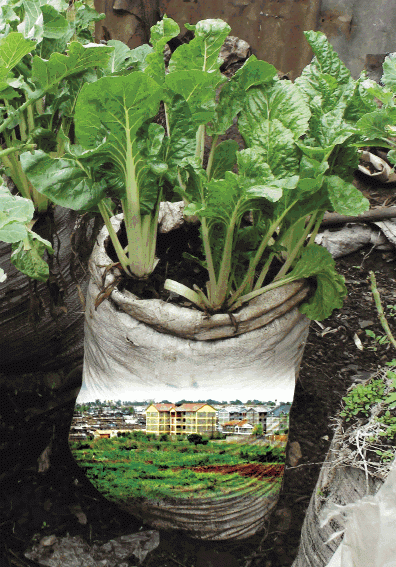Kibera is Nairobi's largest slum/informal settlement. Kibera houses about 250,000 people and is the biggest slum in Africa and one of the biggest in the world. The Government owns all the land in this settlement. 10% of people are shack owners and many of these people own many other shacks and let them out to tenants. The remaining 90% of residents are tenants with no rights. Most of the inhabitants confront themselves with a food crisis. The project at Kibera is a recent initiative of the National Youth Service (NYS), a government agency that promotes youth affairs through the ministry of devolution and planning. The approach is seen as a cheap and healthy solution to food insecurity and runaway unemployment in Nairobi’s slum. The project also addresses climate change as food insecurity is related to an intense period of droughts: longer periods of drought (likely a result of climate change) in sub-Saharan Africa, meant the farmers had to depend on rainfall to water their crops. From a biodiversity point of view, the project will help with the urban biodiversity restoration (1,3)
Overview
Nature-based solution
- Community gardens and allotments
- Allotments
- Community gardens
- Horticulture
Key challenges
- Climate action for adaptation, resilience and mitigation (SDG 13)
- Climate change adaptation
- Green space, habitats and biodiversity (SDG 15)
- Green space creation and/or management
- Water management (SDG 6)
- Flood protection
- Economic development and employment (SDG 8)
- Economic development: agriculture
- Sustainable consumption and production (SDG 12)
- Sustainable consumption
- Sustainable production
Focus
Project objectives
Implementation activities
Climate-focused activities
Climate change adaptation:
- Implement solutions to capture/store water to increase its availability and prevent shortages from droughts
- Increase or improve urban vegetation cover to help reduce outdoor temperature
- Create or improve outdoor spaces to help people escape from urban heat
- Increase the use of climate-resilient plant species (resistant to drought, fire, and pests)
Main beneficiaries
- Citizens or community groups
- Marginalized groups: Socio-economically disadvantaged populations (e.g. low-income households, unemployed), Other
- Food producers and cultivators (i.e. farmers, gardeners)
Governance
Management set-up
- Co-governance with government and non-government actors
Type of initiating organisation
- Local government/municipality
- Non-government organisation/civil society
- Citizens or community group
Participatory approaches/ community involvement
- Co-planning (e.g. stakeholder workshops, focus groups, participatory mapping)
- Consultation (e.g. workshop, surveys, community meetings, town halls)
- Joint implementation (e.g. tree planting)
- Co-management/Joint management
Details on the roles of the organisations involved in the project
Project implemented in response to ...
Financing
Total cost
Source(s) of funding
- Funds provided by non-governmental organization (NGO)
- Other
Type of funding
- Unknown
Non-financial contribution
- Provision of land
- Provision of goods
- Provision of labour
- Provision of expertise
- Exchange of services
- Public authorities (e.g. land, utility services)
- Citizens (e.g. volunteering)
Impacts and Monitoring
Environmental impacts
- Climate change
- Lowered local temperature
- Green space and habitat
- Increased green space area
- Increased number of species present
- Enhanced support of pollination
- Increased spread of native/heirloom/open-pollinated seed
Economic impacts
- Stimulate development in deprived areas
- Generation of income from NBS
Socio-cultural impacts
- Social justice and cohesion
- Fair distribution of social, environmental and economic benefits of the NBS project
- Increased access to healthy/affordable food
- Increased sustainability of agriculture practices
Type of reported impacts
Presence of formal monitoring system
Presence of indicators used in reporting
Presence of monitoring/ evaluation reports
Availability of a web-based monitoring tool
References
2. New Internationalist (2011), KIBERA'S VERTICAL FARMS, available at Source link (accessed 13-03-2022)
3. Dave's Travel Corner (2010), Urban Farming in Kibera, available at Source link (accessed 13-03-2022)
4. Solidarite (2009), A Garden in a Sack: Experiences in Kibera, Nairobi, available at Source link (accessed 13-03-2022)
5. Solidarite (2009), Soaring food prices and nutrition in urban areas - Sack gardens in KENYA, available at Source link (accessed 13-03-2022)



